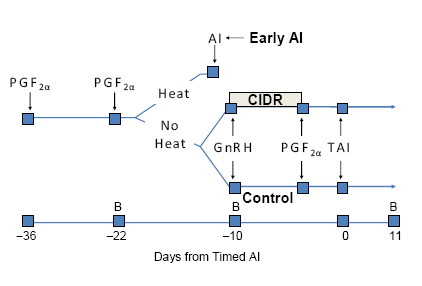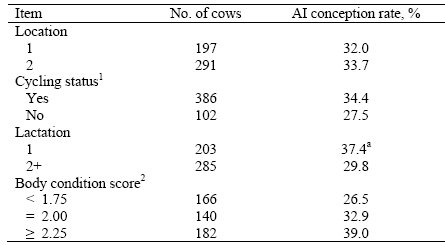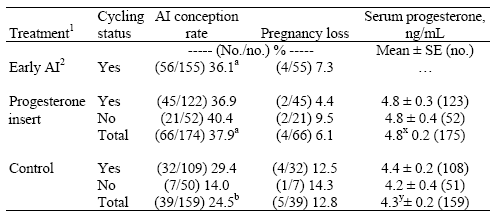Fertility and Reproduction
Timed artificial insemination conception rates in response to a progesterone insert in lactating dai
Our objective was to determine the effectiveness of exogenous progesterone in the form of an intravaginal insert (controlled internal drug release, CIDR) in conjunction with an ovulation-synchronization protocol in lactating dairy cows. Cows received a Presynch protocol (two injections of prostaglandin F2α [PGF2α] 14 days apart) beginning 30 and 36 days in milk, respectively, in two herds.
Cows were inseminated after the second Presynch injection when estrus was detected. Remaining cows were treated with the Ovsynch protocol, and alternate cows were assigned randomly to receive a progesterone insert (CIDR). Blood was collected, and body condition scores (BCS) were assigned to treated cows. Pregnancy status was confirmed by palpation on day 38 post timed AI (TAI) and verified again 4 weeks later.
Progesterone increased conception rates in treated cows when compared with controls (38 vs. 24%), but did not differ from early inseminated cows (38%). Pregnancy loss was numerically less in progesterone-treated cows than in controls (4.4 vs. 11.8%).
Introduction
Fate of a dairy cow lies in her ability to reproduce; however, in an constantly changing dairy industry, reproductive performance has dramatically declined. As a means to manage reproductive programs, ovulation-synchronization protocols were developed. Development of the Ovsynch protocol opened new doors for the dairy producer. Variations of the Ovsynch protocol have been tested to synchronize ovulation by altering timing of gonadotropin releasing hormone (GnRH) and PGF2α injections.
Because GnRH is used to control follicular development and induce ovulation of a dominant follicle and PGF2α causes regression of the corpus luteum (CL), timing of injections can further improve fertility when used at certain stages of the estrous cycle. Follicular development and early maintenance of pregnancy requires endogenous progesterone to be secreted by the CL. Progesterone prevents the return of estrus and is used to synchronize estrus. Integration of exogenous progesterone into a synchronization protocol can prevent estrus in cows before insert removal and TAI.
Other studies have found progesterone treatment of cows before first service to improve TAI conception rates, regardless of whether they had normal estrous cycles before AI. In a previous study, cows were inseminated during 28 days while the Presynch protocol was applied to them (two injections of PGF2α administered 14 days apart). Those not yet inseminated were then treated with a progesterone insert as part of the Ovysnch protocol. Resulting TAI conception rates were improved compared with non-progesterone treated cows. Our objective was to apply progesterone to cows (as part of the Ovsynch protocol) that had not been inseminated during 12 days after the second of two Presynch injections and determine subsequent TAI conception rates.
Procedures
Lactating dairy cows on 2 dairy farms were enrolled in a Presynch + Ovsynch protocol after parturition and assigned randomly (based on lactation number: 1, 2, or 3+) to receive either of two treatments: CIDR or no CIDR if they failed to express estrus and were not inseminated after the second of two Presynch injections (Figure 1). Cows received 2 initial Presynch injections of PGF2α. Cows detected in estrus after the second Presynch injection of PGF2α were inseminated.
Figure 1. Experimental Design of Treatments.

PGF2α = prostaglandin F2α;
CIDR = progesterone releasing intravaginal insert;
GnRH = gonadotropin releasing hormone;
AI = artificial insemination; and
TAI = timed AI.
Remaining cows received the standard Ovsynch protocol and were injected with GnRH and either received a progesterone insert (CIDR) for 7 days or served as controls. After CIDR removal, all cows received an injection of PGF2α. Cows were inseminated at 72 hours after PGF2α and given a second injection of GnRH. Blood samples were collected to analyze concentrations of progesterone before the second Presynch injection in all cows. No further blood collection occurred for cows inseminated during the 12 days between the second Presynch injection and initiation of treatment. Cows assigned to treatment were blood-sampled before the CIDR insert was placed and again 11 days after TAI to determine cycling status of each cow and effect of treatment on post-AI concentrations of progesterone. Body condition scores (1 = thin and 5 = fat) were assigned at the onset of treatment. Cows were diagnosed pregnant by palpation beginning 38 days after AI.
Results and Discussion
Serum progesterone concentrations revealed that the majority of cows were cycling before TAI. At location 1, 39.6% of the cows were inseminated early between the second Presynch PGF2α injection and the onset of the Ovsynch protocol, whereas 26.5% were inseminated early at location 2. Of the remaining 333 cows, 231 (69.4%) were found to have elevated progesterone in either or both samples collected before treatment, indicating that about 30% of the treated cows were not cycling or anovulatory before treatment.
Overall conception rates did not differ between herds (32 vs. 34%) or between cows that were cycling and not cycling (34 vs. 28%; Table 1) before treatment. Younger cows had greater (P < 0.05) conception rates than older cows (Table 1). Cows with more body condition had greater conception rates. Cows having a BCS < 1.75 averaged 12.5 percentage points less in conception rate than those cows having BCS ≥ 2.25 (Table 1).
Table 1. Location, Cycling Status, Lactation Number, and Body Condition Effects on AI Conception Rates

a Different (P < 0.05) from 2+ lactation cows.
1 Based on serum concentrations of progesterone in blood samples collected before the second Presynch PGF2α injection and before the onset of the Ovsynch protocol in progesterone insert and control cows only.
2 Assessed before the second Presynch PGF2α injection.
Timed AI conception rates were greater in cows treated with the progesterone insert compared with controls (38 vs. 25%), regardless of cycling status (Table 2). Early inseminated cows had conception rates similar to CIDR-treated cows. Pregnancy loss in CIDRtreated cows was similar to early bred cows, but less than controls. Concentrations of progesterone 11 days after timed AI tended to be greater than those in controls. Our study shows that increased conception rates can be achieved by using a progesterone insert in a reduced population of cows not yet inseminated. Further, thinner cows had poorer TAI conception rates, and cows in their first lactation were more fertile than older cows. This study is part of a larger, multi-state study in which a similar protocol was applied to cows in Arizona, California, and Wisconsin. Results of the entire study are forthcoming.
Table 2. Conception Rates, Pregnancy Loss, and Serum Progesterone After AI in Lactating Dairy Cows in Response to Treatment

a,b Mean percentages having different superscript letters differ (P < 0.01).
x,y Mean percentages having different superscript letters tended (P < 0.10) to differ.
1 Cows in the Early AI treatment were inseminated after detected estrus following the second Presynch PGF2α injection. The Ovsynch protocol was applied to the remaining cows not inseminated, of which approximately one-half were treated either with a progesterone insert (CIDR) for 7 days beginning with the first GnRH injection or served as controls.
2 At location 1, 37.1% of the cows were inseminated early between the second Presynch PGF2α injection and the onset of the Ovsynch protocol, whereas 24.5% were inseminated early at location 2.























